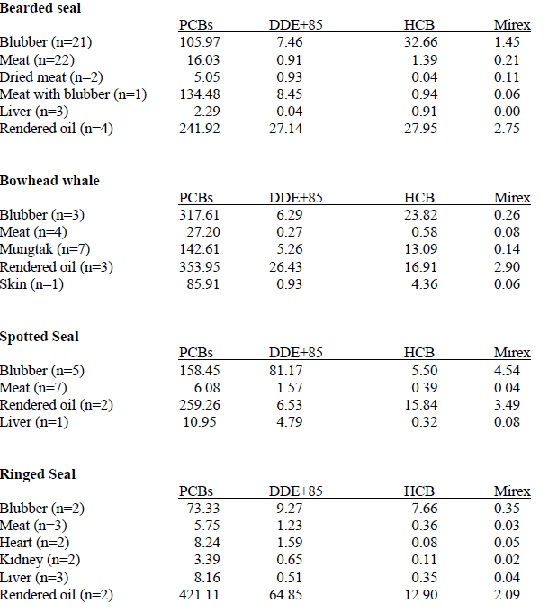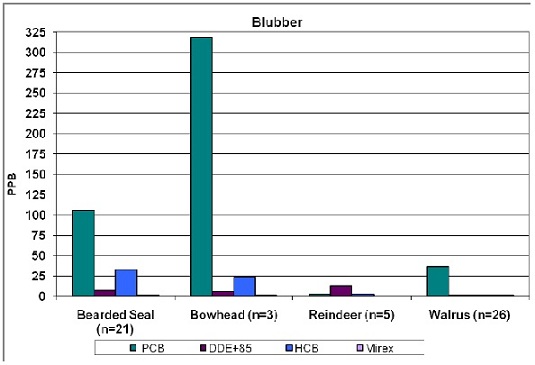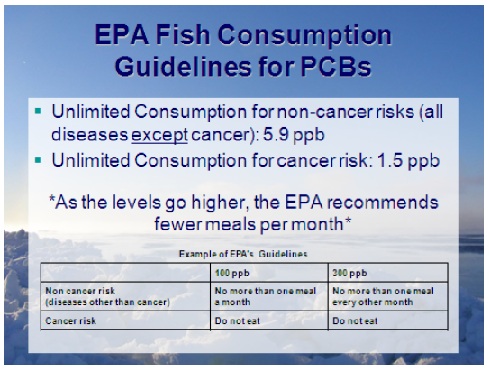Grantee Research Project Results
Final Report: Environmental Contaminants in Foodstuffs of Siberian Yu’piks from St. Lawrence Island, Alaska
EPA Grant Number: R831043Title: Environmental Contaminants in Foodstuffs of Siberian Yu’piks from St. Lawrence Island, Alaska
Investigators: Miller, Pamela K. , Carpenter, David O. , Welfinger-Smith, Gretchen , Eckstein, Lorraine , Waghiyi, Viola
Institution: Alaska Community Action on Toxics , The State University of New York
EPA Project Officer: Hahn, Intaek
Project Period: December 1, 2003 through November 30, 2006
Project Amount: $449,510
RFA: Lifestyle and Cultural Practices of Tribal Populations and Risks from Toxic Substances in the Environment (2002) RFA Text | Recipients Lists
Research Category: Environmental Justice , Tribal Environmental Health Research , Human Health , Safer Chemicals , Climate Change
Objective:
The Yupik people, who reside in the northern Bering Sea region of Alaska on St. Lawrence Island sustain traditional cultural ways of life that rely on a diet of marine mammals, fish, reindeer and local plants. Traditionally harvested foods play a vital role in the health and prosperity of Arctic Indigenous Peoples. Maintaining a traditional diet and continuing to engage in the harvest of traditional foods is essential to the physical, cultural, social, and economic well being of Arctic residents.
The Arctic is significant as an indicator region for long-range transport of persistent organic pollutants (POPs). Assessing human exposure to POPs in the Arctic may improve understanding of exposure pathways so that community-based strategies can be implemented to reduce or eliminate exposures. The Arctic acts as a “cold trap” and is a hemispheric sink for POPs that are transported through a well-documented process known as global distillation via prevailing atmospheric and oceanic currents from warmer regions. Once POPs enter the colder environment of the Arctic, their deterioration is slowed and they accumulate in the food web. Low temperatures and low levels of sunlight prolong the decay of POPs, and they are readily incorporated within biological systems. POPs bioaccumulate in lipid-rich Arctic food webs, some to dangerous levels. Those communities that rely on marine foods as the basis for their traditional diets are at particular risk from contaminant exposure. According to the Arctic Monitoring Assessment Programme, there are “significant exceedances of international and national guideline values for exposure to such chemicals as PCBs.” There is increasing concern about long-term chronic exposures from Arctic marine mammals such as whales, seals, and walruses, because as long-lived animals on higher trophic levels they carry heavy loads of contaminants and are integral components of the traditional diet of Arctic Indigenous Peoples, including the residents of St. Lawrence Island. The Preamble of the Stockholm Convention on Persistent Organic Pollutants, a global legally-binding treaty of 164 nations to phase out certain of the world’s most toxic chemicals, states: “Arctic ecosystems and indigenous communities are particularly at risk because of biomagnification of persistent organic pollutants and that contamination of their traditional foods is a public health issue.” Governments were especially motivated to come together to negotiate the treaty when scientists found that Arctic Indigenous peoples are among the most highly exposed people to POPs in the world. Monitoring data that provide information about the fate of these chemicals in the Arctic are important for national and international decisions necessary to protect public health.
Biomonitoring research supported by the National Institute of Environmental Health Sciences (NIEHS) Environmental Justice and Community-Based Research program in collaboration with the people of SLI indicates that all residents have levels of PCBs and certain pesticides in their blood that are significantly higher than people who live in the lower-48 states, and those living in Savoonga who are also associated with the formerly used military site at Northeast Cape have significantly higher levels than their neighbors on the Island. These data are discussed in a paper published in the International Journal of Circumpolar Health (64(4):322-335 [2005]). Data from the biomonitoring work on SLI as well as air and water monitoring—conducted by the collaborative research team at Northeast Cape and Gambell—suggest that the long-range transport of POPs through oceanic and atmospheric currents to the Island underlies the elevated PCB blood serum levels found in the people of both Gambell and Savoonga—but that the significantly higher levels among those Savoonga residents associated with Northeast Cape indicates added exposures from military contamination.
This community-based research project examined Yupik traditional foods for PCBs, chlorinated pesticides, and heavy metal concentrations. The research team established sample collection protocols and laboratory methods in the first year of the project. Yupik field researchers on St. Lawrence Island (SLI) received training and supplies necessary to collect samples of plants, invertebrates, fish, birds, reindeer, and marine mammals that comprise the subsistence diet of the Yupik people of SLI. Field researchers from St. Lawrence Island, elders and other tribal leaders determined the range and priorities for the types of traditional foods sampled based on seasonal availability and significance to the Yupik diet. Over the course of the project, researchers collected and analyzed traditional food samples representing the diversity of foods of the Yupik people of St. Lawrence Island, including fresh and prepared food samples of herbaceous plants, berries, invertebrates, fish, birds, and marine mammals—a total of 576 samples were analyzed, 338 for 100 PCB congeners, two pesticides, HCB and mirex, and the pesticide metabolite, p-p’-DDE+85; and 238 samples for metals. The research team worked with Yupik hunters and heads of households in the St. Lawrence Island villages of Savoonga and Gambell to collect tissue samples from freshly killed animals and those that had undergone preparation for consumption (e.g. boiled, dried, and rendered). Samples include organ (liver, kidney, heart), brain, and muscle tissues; blubber; and rendered oils from such species as reindeer, Pacific walrus, ringed seal, bearded seal, spotted seal, bowhead whale, gray whale, minke whale, and polar bear. Samples were analyzed at the University at Albany Institute for Health and the Environment.
Summary/Accomplishments (Outputs/Outcomes):
Methods
Tissue Sample Extraction
Aliquots of 1g, 5g and 10g were used for fat/blubber, meat and skin, and plant samples respectively. 10 mL of 1:1 hexane:acetone was added with 5 g of Na2SO4 and two surrogate standards (IUPAC 125 and 192; 10 µL of a 1ng/µL solution of each in acetone). Samples were homogenized until a slurry was formed (~2 min). The solvent was collected, and the extraction was repeated twice more, combining the three extracts, which were then brought to a final volume of 50 mL with hexane. 5mL of combined extract was removed and placed in a tared weigh tin for gravimetric total fat determination. The remaining extract was concentrated to ~1 mL for cleanup.
Rendered Oil Extraction
0.2 g of rendered oil was combined with 2 mL of hexane and 10 µL of the combined surrogate standards (IUPAC 125 and 192; 10 µL of a 1ng/µL solution of each in acetone) was added with 1 mL H2SO4. Samples were vortexed for 1 minute. 1 mL was transferred to a Florisil column for cleanup.
Sample Cleanup
Sample extracts were transferred to a 1x15 cm glass columns containing 10g of calibrated, 4% deactivated Florisil overlaid with 2 g anhydrous sodium sulfate. The column was eluted with hexane and a predetermined amount of eluate was collected and concentrated to 1 mL for analysis.
Analysis
High-resolution, congener-specific analysis was performed using a splitless dual-column gas chromatograph with dual electron-capture detection (GC-ECD) was employed which allowed for the determination of 100 PCB congeners, including seven pairs of co-eluters and one triplet congener co-elution. Two pesticides, HCB and mirex, and one pesticide metabolite, p-p’-DDE+85, were also analyzed concurrently. Dr. Arnason’s laboratory conducted the metals analysis according to approved methods, including total mercury analysis by Cold Vapor Atomic Absorption Spectrometry and total Cr, Cu, Zn, As, Se, Cd, Sn, and Pb by Inductively-coupled Plasma Mass Spectrometry.
Findings
The importance of the harvest of subsistence wild foods for the people of St. Lawrence Island cannot be overstated. It is a defining attribute of the residents’ way of life. Harvest activities are often communal; nearly all village residents are involved in the processing of whales in spring and fall, and the meat is divided among them. Traditional foods are shared with village elders and others who are unable to hunt, fish, or gather wild foods. These harvest activities are a necessary part of maintaining cultural identity. If wild foods were denied to SLI, the likely result would be the deterioration of public health, as their foods are nutrient dense (containing critical nutrients such as folic acid, vitamins C & D, iron, and zinc); high in protein, fat (particularly omega-3 fatty acids), and antioxidants; and low in carbohydrates. Loss of traditional foods would likely result in social instability because the cost of buying and transporting replacement foods would be impossible for residents, or even governmental agencies, to bear over time. The long-term consequences would not be starvation but the gradual erosion and disappearance of the community through out-migration of residents, and, ultimately the disappearance of a unique culture, language, and people. Subsistence foods for SLI include fish, marine mammals (several species of seals, walrus, and whales), intertidal invertebrates, waterfowl, seabird eggs, reindeer (domesticated caribou), berries, roots, greens, and medicinal plants.
The research team collected and analyzed a wide range of fresh and prepared traditional foods to determine food safety. Data indicate high levels of PCBs in the rendered oils and blubber. As a frame of reference, the U.S. EPA published a risk-based consumption limit for PCBs in fish of 1.5 parts per billion (ppb) so as to avoid excess risk of cancer. Omega-3 fatty acids in traditional foods likely provide cardiovascular benefits, yet there is no evidence that omega-3 fatty acids protect against cancer. Most meat samples and greens from our SLI study were near this value, with the exception of polar bear and glaucous gull, both of which were significantly higher (polar bear muscle tissue mean=13.23, n=4; glaucous gull muscle tissue=78.05, n=1). Results show meat/muscle tissue for most species and the plant species to be lowest in contaminant concentrations. However, levels of PCBs [all values reported on a wet-weight basis] in bowhead mungtak (small pieces of whale blubber and skin) ranged up to 528 ppb, with a mean level of 143 (n=7). High levels of PCBs were also found in rendered oils: walrus (mean = 194 ppb, n=7), bearded seal (mean = 242 ppb, n=4), bowhead whale (mean = 354 ppb, n=3), ringed seal (mean = 421 ppb, n=2), and spotted seal (mean = 259 ppb, n=2). Rendered oils and mungtak are essential components of the Yupik diet and consumed on a regular basis throughout the year. In contrast, analyses of total mercury revealed that organ tissues of certain species such as reindeer kidney had higher levels than found in meat and fat tissues. Total mercury concentrations in reindeer kidney ranged from 0.633-2.20 ppm (mean = 1.41, n=4)(values reported on a wet weight basis). Total mercury concentrations in walrus liver ranged from 0.100-1.35 (mean = 0.56, n = 11). Mercury levels in Arctic loon muscle and liver tissue also exceeded 0.5 ppm. These levels of mercury are cause for concern, as they exceed health based standards.
Data for some of the species and tissues of greatest importance in the traditional diet are summarized below with mean values reported in parts per billion on a wet-weight basis:
The project team conducted a series of meetings with the Native Village of Gambell and Native Village of Savoonga tribal leadership and with the community in the villages of St. Lawrence Island to discuss the implications of the results and with the awareness that traditional foods are vital to the well-being and culture of the Yupik people. The research team discussed the results in the context of the recognized nutritional and cultural benefits of the traditional diet. The leadership of the St. Lawrence Island communities emphasized the need to continue collaborative community-based research and to find ways to reduce exposures while continuing reliance on the traditional diet.
Additional presentations included: 1) National Tribal Forum on Environmental Science, Quinault Indian Nation, WA (September 2006); 2) International Society for Environmental Epidemiology (ISEE), Pasadena, CA (October 2008); 3) Alaska Forum on the Environment, Anchorage, AK (February 2009); 4) American Association for the Advancement of Science (AAAS), Chicago, IL (February 2009); 5) Kawerak Regional Health Conference, Nome, AK (February 2009); 6) Fourth meeting of the Conference of the Parties of the Stockholm Convention on Persistent Organic Pollutants, Geneva (May 2009); 7) Arctic Monitoring and Assessment Programme and Northern Contaminants Programme Human Health and Arctic Environmental Contaminants Conference, Iqaluit, Nunavut, Canada (June 2009); 8) University of Alaska Community-Based Research Institute, Nome, AK (July 2009); 9) 15th Annual Alaska Tribal Conference for Environmental Management, Anchorage, AK (November 2009); 10) Strengthening Environmental Justice Research and Decision Making: A Symposium on the Science of Disproportionate Environmental Health Impacts, Washington DC (March 2010—paper accepted entitled Contaminants in the Traditional Foods of the Yupik People of St. Lawrence Island, Alaska—Exposure Pathways, Collaborative Interventions, and Prevention).
Conclusions:
We conclude that rendered oils, mungtak, and blubber comprise major dietary sources of PCBs, as they are vital components of the traditional diet and consumed on a regular basis by the St. Lawrence Island Yupik people. Organ meats of certain animals such as reindeer and walrus contain levels of mercury that exceed health-based standards, although the organ meats are consumed less frequently. Additional samples and analyses of emerging contaminants (e.g. PBDEs & PFCs) are needed, particularly for the rendered oil, liver, and blubber, to ensure accurate representation of the nature and variability of contaminant levels in foods crucial to the Yupik diet. Finally, the research team and community collaborators emphasize the need for state, national, and international agreements that eliminate the production and trans-boundary transport of persistent organic pollutants and heavy metals into northern regions. Proactive policies are essential to the protection of the health of present and future generations of the St. Lawrence Island Yupik and all Arctic Indigenous peoples.
Journal Articles on this Report : 2 Displayed | Download in RIS Format
| Other project views: | All 12 publications | 2 publications in selected types | All 2 journal articles |
|---|
| Type | Citation | ||
|---|---|---|---|
|
|
Miller PK, Waghiyi V, Welfinger-Smith G, Byrne SC, Kava J, Gologergen J, Eckstein L, Scrudato R, Chiarenzelli J, Carpenter DO, Seguinot-Medina S. Community-based participatory research projects and policy engagement to protect environmental health on St Lawrence Island, Alaska. International Journal of Circumpolar Health 2013;72:21656 (11 pp.). |
R831043 (Final) |
Exit Exit |
|
|
Welfinger-Smith G, Minholz JL, Byrne S, Waghiyi V, Gologergen J, Kava J, Apatiki M, Ungott E, Miller PK, Arnason JG, Carpenter DO. Organochlorine and metal contaminants in traditional foods from St. Lawrence Island, Alaska. Journal of Toxicology and Environmental Health, Part A 2011;74(18):1195-1214. |
R831043 (Final) |
Exit Exit |
Supplemental Keywords:
DDE, hexachlorogenzene, mirex, blubber, salmon, polar bear, reindeer, mercury, cadmium, lead, arsenic, human health, geographic area, scientific discipline, health, risk assessments, health risk assessment, ecological risk assessment, exposure, state, lead, cadmium, human health risk, biomarker based exposure inference, Siberian Yupiks, dietary exposure, petroleum waste, mercury, metals, pesticides, PCB, human exposure,, Health, Scientific Discipline, Geographic Area, HUMAN HEALTH, Ecological Risk Assessment, Health Risk Assessment, Risk Assessments, State, Exposure, dietary exposure, lead, pesticides, Siberian Yu'piks, cadmium, human exposure, PCB, Alaska (AK), human health risk, metals, biomarker based exposure inference, mercuryProgress and Final Reports:
Original AbstractThe perspectives, information and conclusions conveyed in research project abstracts, progress reports, final reports, journal abstracts and journal publications convey the viewpoints of the principal investigator and may not represent the views and policies of ORD and EPA. Conclusions drawn by the principal investigators have not been reviewed by the Agency.







